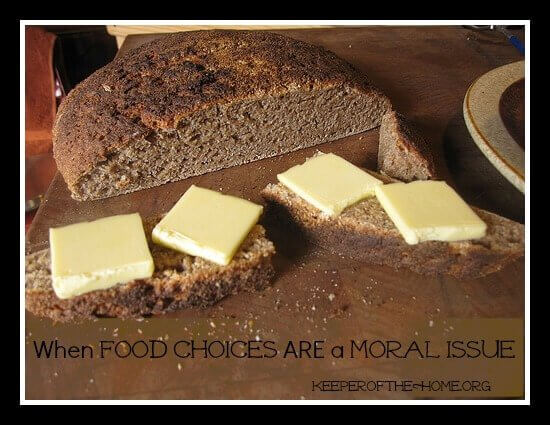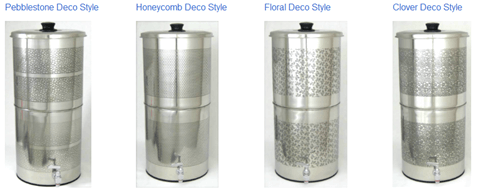7 Foods to Avoid
 Guest Post by Kresha of Nourishing Joy
Guest Post by Kresha of Nourishing Joy
Are you working to ditch processed foods and put more real food on the table? This month we’re running a series called Real Food Made Simple: A Beginner’s Guide to Eating Better. Our goal is to answer the questions you might have and make the transition a whole lot easier!
Up until a few years ago, I’d always been rather naive when it came to ingredients in packaged foods. “Surely,” I thought, “they wouldn’t use anything that wasn’t actually an ingredient.” But as my family and I started our real food journey and I started reading labels, I realized I was sorely mistaken. It can be overwhelming to sort through the myriad dietary options we have, especially when life is busy, so here’s a quick list of seven items to avoid on your own real food journey.
A word of grace here. This is just a list of information – guidelines, if you will. Know that all of us – yes, all of us – don’t always follow them either. Don’t feel frustrated if you don’t keep this list “perfectly” – do what you can and at the end of each day, be joyful and satisfied that you are taking any steps at all toward healthier living.
And here’s a shameless plug: because I was frustrated by all the hidden stuff in my food, especially my kids’ favorite ketchup, mustard, barbecue sauce, and salad dressings, I wrote a cookbook to make all our favorite condiments at home – ones that look and taste like the store-bought versions! You can see what’s inside here.
image by Hadleygrass is asparagus
Refined Sugar
In 1800, the average American ate about 4 pounds of sugar each year (source). In 2011, the average per person was closer to 150 pounds. Obviously, something has changed. The big deal with sugar is that most of the sugar we’re exposed to is highly refined. In its purest forms (think honey and maple syrup), sugar also includes beneficial minerals, vitamins, and the enzymes necessary to digest the sugar. But in our modern versions (yes, white table sugar and corn syrup, I’m looking at you), all those beneficial elements have been stripped away. Thus, our bodies get the load of sugar without receiving any benefits of the trace minerals.
A Wiser Choice:
- Use minimally refined sugars such as honey, maple syrup, coconut sugar, sucanat, or evaporated cane sugar.
- Read “21 Ways to Eat Less Sugar” as well as “Sweeteners: How they Affect You, Which Ones are Best and How to Use Them.”
- Also, remember that a sweetener doesn’t have to be sugar to be sweet. Using spices such as cinnamon, nutmeg, cloves, and ginger or plant extracts such as stevia, mint, and lavender can give the sensation of a sweet treat without the overload of sugar.
High Fructose Corn Syrup
Yes, we already mentioned sugar, but high fructose corn syrup is a particularly insipid refined sugar worth mentioning all on its own. At first glance, HFCS may seem rather innocuous – after all, it’s a natural sweetener because it’s made of corn, right? Not so much. Most corn grown in the US is genetically modified (nasty stuff). And along with that, HFCS helps you overeat, makes your liver pretend you’re a raging alcoholic, causes memory loss, interrupts your ability to process emotion, and helps you gain fat, especially around the belly. Lovely.
A Wiser Choice:
- Buy foods that only list minimally refined sugars (like the ones listed above) and skip high fructose corn syrup and its refined cousin, agave nectar, entirely.
image by DixieBelleCupcakeCafe
Food Dyes
Did you know that modern food dyes are made from petroleum? They’re known for causing hyperactivity and allergic reactions like welts and hives, and the only reason they’re used in food is to mimic the vivid colors of nature– after all, typically the more colorful the food, the more nutrient-dense it is: think leafy greens, beets, and bell peppers.
A Wiser Choice:
- When buying packaged products, look for those with vegetable-based colors, such as “annatto,” “paprika extract,” or “beetroot red.”
- When needing to use food dyes at home, make your own dyes. (See how beet juice, for example, makes gorgeous pink frosting in these dark chocolate cupcakes with pretty pink buttercream or how turmeric makes a perfect yellow mustard.)
Preservatives
It’s ironic that preservatives – which are intended to preserve food – do anything but preserve your health. Preservatives lurk in pretty much every boxed food out there. Even plain ingredients can be suspect, like most all-purpose flours, which have potassium bromate and chlorine bleach in order to keep them from oxidizing. The problem is, most industrial preservatives are known carcinogens and can cause a host of digestive issues.
A Wiser Choice:
- Buy fresh foods (be sure to wash fruits and vegetables).
- Buy organically-grown foods.
- Look for preservatives that are slightly more “natural,” usually listed as “tocopherols” or anything that sounds like a vitamin, like “ascorbic acid,” or “beta carotene.”
- For flour, look for products that say, “unbromated” or “no additive.”
- There’s a really helpful list of preservatives – the good, the bad, and the ugly – at The Center for Science in the Public Interest.
image by Dominik Schwind
MSG: “A Rose by Any Other Name…”
Ah… MSG. We’ve all heard of it – but what is it, really? Basically, monosodium glutamate is an amino acid, one of those “good guys” who help our bodies function. However, MSG’s job is to trigger messages to the brain, which means that if you’ve got extra glutamate floating around, it’s like an overactive two-year-old on sugar trying to get your attention. Total overstimulation of the brain, which is why over time exposure to MSG tends to cause things like migraines and hives. MSG also tends to cover up non-ingredients and pass them off as real ingredients. The message that your brain receives when it tastes MSG is that it’s getting protein and therefore food manufacturers can add in wood pulp (no, I’m not kidding), throw in some MSG, and our brains will still think we’re getting a nutritious meal. Now, the most slippery thing about MSG is that it has about 40 different names, so it’s darn difficult to avoid. You can see the entire list at TruthInLabeling.org, but basically, if the words “hydrolyzed,” “amino acid,” “protein,” “enzyme,” “yeast extract,” “flavoring,” or any long, chemical name appear on the label, it’s likely got MSG.
A Wiser Choice:
- Buy fresh foods and foods that list “sea salt” as a flavor additive.
Genetically Modified Organisms (GMO Ingredients)
Today, more than 80% of all processed food includes genetically modified ingredients – and that means that most of us are eating them and don’t even know it. But what’s so bad about GMOs? After all, we eat foods that have been cross-bred all the time. The difference is that cross-breeding involves the same species – i.e. a hardy tomato and a juicy tomato cross-breed to create a hardy-juicy tomato. Genetic engineering injects genes from an entirely different species, say an arctic fish into a tomato, to create a new type of tomato (in that case, it was an experiment to see if it would make the tomato resistant to cold). Now, none of us have purchased a fish-tomato, and most GMOs we encounter in our food supply are there just to make the plant resistant to certain pesticides and herbicides. But that also means that our food is extra-laden with those chemicals when we purchase them. However, there has been almost NO testing done on the safety of GMOs. If no testing is allowed for food safety, then we’re basically using ourselves as human guinea pigs, and I, for one, would prefer not to, thankyouverymuch. Foods using GMO ingredients are also not required to be labeled in the U.S. or Canada, despite the fact that nearly every other developed nation in the world already requires labeling. So, suffice it to say, GMOs lurk around nearly every corner, pose potentially numerous health risks, but there’s no way to know whether they’re safe or not.I, for one, would rather be safe than sorry.
A Wiser Choice:
- Buy organic (which isn’t allowed to include GMO ingredients).
- Buy as much of your diet from the local farmer’s market as possible and ask the farmer if they used GMO seed or feed.
- Keep this list of likely GMO foods in your back pocket when you go shopping.
image by tellumo
Trans-Fats
Here’s a scary thought: packages can legally emblazon “0 g of trans-fats!” on their packaging as long as it has less than 0.5 g per serving. So, by decreasing the size of the serving they list on their ingredient label, they can still include trans-fats AND tell you that there aren’t any trans-fats. No wonder we moms get headaches at the store. Sigh. But what are they? Basically, any oil that should be liquid at room temperature but is chemically changed in order to be solid at room temperature is a trans-fat.Margarine and vegetable shortening are good examples, although anything with “hydrogenated” or “partially hydrogenated” on the label is a trans-fat.
A Wiser Choice:
- Use fats that are naturally solid at room temperature, such as butter, coconut oil, and lard, for cooking, baking, and spreading.
- Use fats that are naturally liquid at room temperature, such as olive oil, for salad dressings and dips.

Other posts in the series:
Real Food Made Simple: A Beginner’s Guide to Eating Better
Cutting Your Kitchen Prep Time in Half — Or More!
Confessions of a Formerly Picky Eater
The Grain Controversy: Should We Eat Them or Not?
Second Steps Towards Eating Real Foods: Switching Your Food Sources
Sweeteners: How They Affect You, Which Ones are Best, and How to Use Them
Simple Steps to Begin Cooking Homemade: Pantry Staples
5 Strategies to Help Your Husband and Kids Transition to Real Food
Finding Real Food in the Grocery Store
20 Easy Real Food Switches and Substitutions {with Free Printable Chart}
First Steps to Eating for Fertility
Keeping Costs Down in a Real Food Kitchen
5 Ways to Get More Fruits & Veggies into your Diet
Food Is Not Cheap: 4 Steps to Budgeting in Real Food
Simple Steps to Begin Cooking Homemade: Baked Goods
Simple Roast Chicken (And Fabulous Side Dish Recipes!)
17 Homemade Spice Mixes {with Recipes & Why You Should Use Them!}
5 Ways Green Living and Real Food are Connected
Simple Steps to Begin Cooking Homemade: Soups, Sauces, and Simple Dinners









Well said! About ten years ago, I was educated on the many names of MSG, it was huge, since MSG triggers an immediate migraine in me. My husband recently picked up a box of organic chicken broth from a well known health food grocery store that included a hidden name for MSG! Wow, I was shocked and I’ve been making my own ever since. Thanks for this list, I’ll be sharing it with friends!
I have began doing research on eating more whole foods. I am so glad you started this series. This article alone has helped me understand more than all the research I have done. This lets me know that yes, I can do this. Thank you so much!
Here’s my list: http://www.thebluehouseblog.com/2012/05/five-things-i-try-to-never-feed-my-kids.html. It’s almost impossible to buy anything pre-packaged these days; EVERYTHING has MSG in it!
Great post – lots of great information that most people don’t know! Thanks for sharing.
Agh this is so frustrating! HFCS is the worst for my husband because he is allergic to it. I’ve been reading labels like crazy because even a little of it makes him want to scratch his skin raw. Thank you for sharing this information!
Do you really want to know??? Double Stuf Oreos. Ack!. I have been well aware of the hydrogenated oils in them for many years (and I believe they are one that claims “no trans-fat” now on the packaging). However, they are my guilty pleasure. We do not keep them in the house but I might sneak in a package 2-3 times a year. There, sue me! 🙂
I agree with all the ones you mention… but also feel that food sold in cans should be on that list… the BPA in the cans is an extreme health hazard, and very avoidable.. we simply dont buy cans… I also cannot say enough good about the benefits of using coconut oil… We purchase ours from Wilderness Family Naturals, in 5 gal containers.. all org, and flavorless. We add to smoothies, baking, etc… We do consume org raw sugar in our coffee… no substitute I’m afraid.. 😉
Thank you for the post. You recommend LARD as a good food, I doubt it. I thing God told his people NOT to eat it for a reason. Any thoughts on it?
Lard is actually an excellent food, especially when it’s been raised on pasture where the pig access to sunshine and appropriate forage. Stephanie wrote a great article with tons of links if you’d like to read more: Good Fats, Bad Fats, and Why I Eat Plenty of Butter.
And you’re exactly right – I’m sure God had good reason for instructing His people not to eat pigs in the Levitical law. People have argued for millennia about dietary food laws and thank God we have grace in all our ponderings about how to live (and eat) in holy ways. Pigs, perhaps, were given special mention in the Levitical law because their flesh and fat is more susceptible to the storing of toxins than the ruminant animals that were declared “clean,” but since by and large, Christians agree that the Levitical law was completed with the sacrifice of Christ and thus Christians don’t tend to pay attention to those laws in the same way as our Jewish brothers and sisters, I personally take that instruction as one more reason to seek out properly raised animals. God certainly was looking out for our health, but I suspect in this case it was more for the sake of avoiding food-borne illness than avoiding a certain type of fat.
Thanks for a great comment.
Thank you Kresha! I too think that we are under grace and it will not change a thing for salvation. But I am reading the “What the Bible says about healthy living” book by Rex Russell. It gives a whole new perspective on what the Bible says about food. It is very new to me and I am eager to learn. Thanks again.
Question: I’ve struggled with this hidden MSG problem–I find it overwhelming. If the package says: No MSG, but then lists yeast extract or something the package is a lie, right? What about protein powders for smoothies–full of all sorts of amino acids and protein, so does that equal MSG? I read the truth in labeling list months ago and from what I understand pretty much anything that has protein in it has MSG. The only packaged foods I really buy are broth (claiming no msg) and the hormel no perservative deli meat that has celery juice powder and says no msg added? Making everything from scratch, homeschooling, cloth diapering, keeping a livable house (not clean, just decent), growing a garden, teaching Sunday school–I’m exhausted and overwhelmed. I’ve always loved the pioneer idea but I don’t know how to find the time–and I have all the technology to speed things up.
Erika,
Thank you for an excellent and heartfelt comment. You’re so right – living the “simple” life is often anything but simple and yes, it is often exhausting. I SO relate with everything you’ve said. For me, the only survival tactic I can recommend is to find the moments of joy in your life and nourish them so that your spirit is well-fed through the rest of the day – enjoy a tea, see if you can take fewer turns in the Sunday School rotation, etc. Perhaps other readers can chime in with their own ideas and tactics. 🙂
Anyway, your question was about MSG. Most protein powders, yes, by nature contain large amounts of MSG, although some boutique protein powder brands claim that their methods do not produce it. I am not qualified to go to task with those brands, but suffice it to say, any time protein exists by itself, there will be extra glutamates floating around in your body, so I tend to avoid them.
But the larger point is, just pay attention to your body. If you have sourced a good brand – be it protein powder, broth, or deli meats – and you feel good without any side-effects after eating it, then don’t worry about it at this point in time. You’ve obviously done a very good job already of thoughtfully minimizing your family’s exposure to MSG. Take great satisfaction in that, as that’s not an easy task. 🙂
Erica,
I’ve been thinking a lot about your comment over the last couple of weeks, and it led me to write a two-part post over on my own site, which you can see here: http://www.nourishingjoy.com/why-the-simple-life-is-rarely-simple/.
I’ve been praying for you, as well as the number of other women I’ve heard say the same thing about the “simple” life. Many blessings to you and your family!
Ach! I meant “EriKa!” I hit publish too quickly. I’m so sorry – please forgive me!
There is a wonderful company called Maggie’s Naturals that makes some great all natural food dyes!
We just had a friend from Nepal staying with us. She brought MSG to cook with, “cause it make at he food tasty”. Thanks for the info to send along to her. I’m sure her American husband will appreciate it 🙂
Oh and we said no thank you to the MSG.
Actually there is increasing recognition to have the effects of annatto as a potentially harmful additive at the very least looked into. Just because something is ‘natural’ does not make it a better choice…
http://fedup.com.au/factsheets/additive-and-natural-chemical-factsheets/160b-annatto
I called customer service for one company to make sure that MSG wasn’t included as “spices”; I let her know that the reason was because of ds who is severely allergic to it. She checked and said that according to the USDA regulations only MSG, Monosodium Glutimate, yeast extract or autolyzed yeast extract could be used on labels.
Artificial sweeteners is a big one for me. I try very hard to minimize our exposure to sugar, I don’t keep white sugar (even organic) in the house anymore, but when we are at a church potluck or something similar I will relax and let them have a dessert. However I start to freak out a little bit if artificial sweeteners are around because I do NOT want those chemicals in my sweet toddlers’ bodies! Or my own, pregnant body for that matter. Salad dressings are bad for that because, while we only have homemade salad dressing at home, I sometimes forget to check the label when we are out. Or helpful church friends will serve my three year old a cup of fruit punch without checking with me first (ugh!). I am really not super anal when we are out and about – I even let them eat fast food sometimes when we are road-tripping to my parents. But artificial sweeteners are where I draw the line!
Hi Joy!
I just wanted to comment that this is a great resource! I did, however, recently do a ton of research into the info in the Truth in Labeling site and found it to be really misleading. It appears there is some real question about the author’s accuracy. I hope to post on it soon, but his assertions about MSG like problems from foods w/ glutamate don’t appear to hold up with other research. Thanks, however, for all of this. A truly thorough help!
Amazing, amazing resource.. Thanks so much Kresha for putting it together.. While I read labels closely, MSG is one thing that may have been sneaking in due to all its different and natural-sounding names.. Thanks!
You’re so welcome! I’m glad it’s of good use. 🙂
Mostly good info. I would like to clarify the part about GMOs. A product has to be 100% organic to be free of GMO ingredients. If not 100% organic it may contain up to 30% GMO.
Thank you so much for this information! We as a family are working on losing weight and incorporating whole foods into our diet. Your article was very easy to understand and I am really enjoying this series on the Whole Foods subject 🙂
eergh! I thought I’d found an OK with Stevia but according to the link,The Center for Science in the Public Interest. Stevia is a “caution”. It is so hard to cut back sugar, why can’t it be easier?
That’s an excellent question! And you’re so right – it should be easier to cut back on sugar!!!
I would imagine that they’ve listed it as a caution because most of the powdered forms of “stevia” are actually “rebiana,” an extracted, highly-processed PART of the stevia plant. Pure dry, ground stevia (as in, the plant was picked, dehydrated, and powdered) and most liquid stevia extracts are much safer (and healthier). Kristen over at Food Renegade has an excellent post on one of the rebiana brands, TruVia, where she explains the difference in greater detail.
I hope that helps!